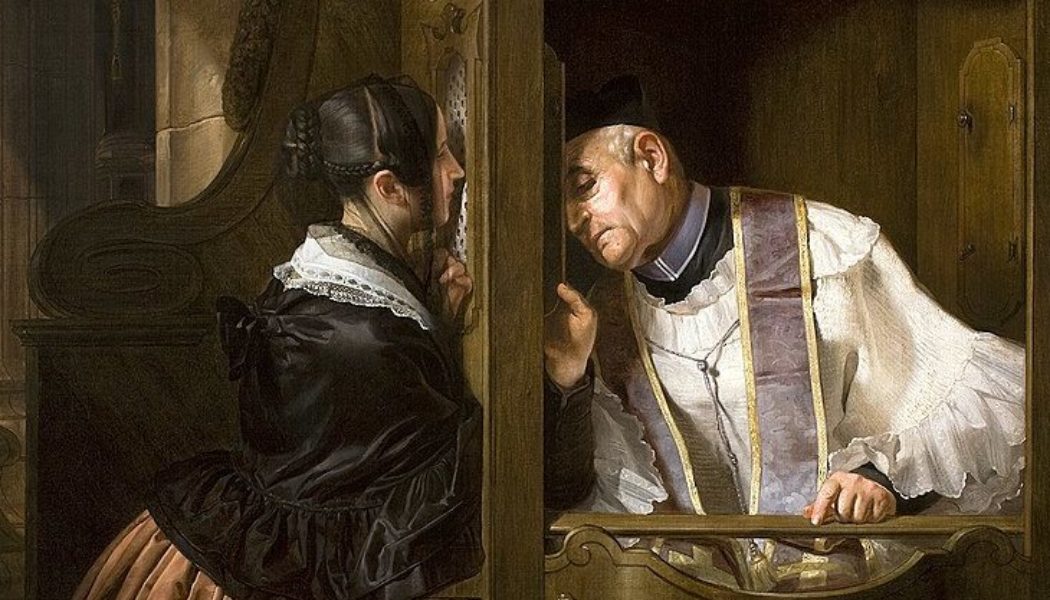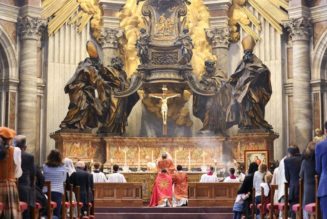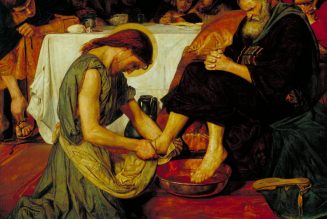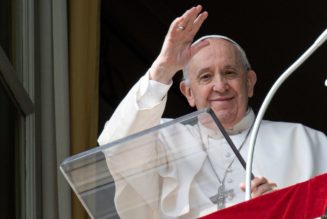
Each year at the seminary where I teach, I walk my students through the sacrament of Reconciliation as it is found in the liturgical book The Rite of Penance. They are always surprised by what is and what is not found in the ritual book. Indeed, the typical experience of many penitents seems to be an abbreviated or limited version of the full liturgical wealth the rite has to offer. The Rite of Penance contains both spiritual profundity and great theological significance, and a careful and more ample celebration has the potential to contribute to a renewal of the sacrament of Reconciliation. So here are seven things you may not know about the Rite of Penance (hereafter RP).
1) How Does the Rite of Penance Begin?
In my experience as a penitent, the way the sacrament of Confession begins can be a bit of a wild-card. Will the priest initiate the interaction, or will he wait in silence for me to start? Does he greet me with an invitation to trust in God’s mercy, or does he begin with the sign of the cross? Maybe I should jump right in with “Bless me Father for I have sinned”?
So, how does the Rite of Penance envision this sacrament commencing?
That is a bit of a trick question, because the Introduction contained in the ritual book calls for a preparation that occurs before the penitent ever steps into the confessional. “The priest should call upon the Holy Spirit so that he may receive enlightenment and charity. The penitent should compare his life with the example and commandments of Christ and then pray to God for the forgiveness of his sins” (RP, 15). So, both the priest-confessor and the penitent are instructed, albeit differently, to prepare spiritually for the sacrament. The priest invokes the Paraclete, whom the words of absolution remind us was sent among us for the forgiveness of sins. The penitent undertakes an examination of conscience, praying for forgiveness. The Holy Spirit is certainly at work also in the heart of the penitent since “this same Spirit who brings sin to light is also the Consoler who gives the human heart grace for repentance and conversion” (Catechism of the Catholic Church (CCC), 1433).
Once the penitent has entered the confessional, however, the rite begins with the reception of the penitent, and it is the priest who is instructed to take the initiative: “When the penitent comes to confess his sins, the priest welcomes him warmly and greets him with kindness” (RP, 41). The Introduction adds similarly that “the priest should welcome the penitent with fraternal charity and, if the occasion permits, address him with friendly words” (RP, 16). While on a purely natural level, the greeting of the priest establishes both a welcoming atmosphere for the penitent and a comfortable rapport with the priest, more is involved here. The priest stands in the person of Christ and so in speaking the first words of the encounter, he manifests sacramentally the initiative Christ takes in reconciling the sinner. Wherever God’s grace meets our response, the first move is always one of divine, prevenient generosity. “God shows his love for us in that while we were yet sinners Christ died for us” (Romans 5:8). The priest also represents the father of the prodigal son who, while his son was yet at a distance, saw him, and ran and embraced him, before the son could even recite his rehearsed list of sins (Luke15:20).
Following this welcome, it is then the penitent who makes the sign of the cross with the usual accompanying formula, “which the priest may make also” (RP, 42). The priest invokes the Holy Trinity, making the sign of the cross at the absolution from sin. Here the penitent’s first action is the sign which both recalls the baptism that originally freed him from sin, and the Paschal Mystery of the Lord’s Cross, through which that reconciliation was objectively achieved once for all, and is being applied to this person here and now.
2) There Are Different Forms of the Reception of the Penitent
As a further element of the reception of the penitent, the priest is instructed to invite the penitent to have trust in God, in these or similar words: “May God, who has enlightened every heart, help you to know your sins and trust in his mercy” (RP, 42). While we may be familiar with this formula, most don’t realize that the rite provides several other forms of reception of the penitent, many of which are inspired by the words of scripture (RP, 67-71). For instance, one such invitation to trust in God invokes the words of Ezekiel 33:11, saying, “The Lord does not wish the sinner to die but to turn back to him and live. Come before him with trust in his mercy” (RP, 67). Other options echo the words of Luke 5:32 and 1 John 2:1-2. A principle is operative here that is present throughout the Rite of Penance. While the rite at times allows for some flexibility in expression used by the priest, it is also the case that the liturgical words favor the use of the inspired scriptures. The latter carry an authority and efficacy that our own words, eloquent though they may be, cannot equal.
3) What about “Bless me Father for I have Sinned?”
Most of us learn this formula when we make our first confession, and we include with it the time elapsed since our last confession. It may surprise you to learn that this formula is wholly customary, and not found in the rite itself. The Introduction does indicate, however, that “if the penitent is unknown to the priest, it is proper for him to indicate his state in life, the time of his last confession, his difficulties in leading the Christian life, and anything else which may help the confessor in exercising his ministry” (RP, 16).
The well-known formula certainly serves part of the purpose here, but in addition to the time since the last confession, the rubric suggests three other elements. First, the penitent declares his or her state in life—married, parent, ordained, religious, etc. Next, the penitent makes known any difficulties in leading the Christian life. These are not sins per se, but those aspects of one’s life that provide the greater context for one’s actions. Think here of things like struggles with addiction, mental health issues, or scrupulosity. Finally, the rite includes “anything else” that, along with those items already mentioned, will help the confessor as both judge and physician. For example, this would be a fitting time for the penitent to mention if he is particularly nervous about being there or needs help making a good confession.
4) The Rite Includes an Optional Reading of the Word of God
Perhaps most surprising to many is that the Rite of Penance for individual confession includes an optional reading from the word of God. “Then the priest may read or say from memory a text of Scripture which proclaims God’s mercy and calls man to conversion” (RP, 43). The Introduction explains that “through the word of God the Christian receives light to recognize his sins and is called to conversion and to confidence in God’s mercy” (RP, 17). Pope Benedict XVI commented that “the role of sacred Scripture in these sacraments [of healing] is often overlooked, yet it needs to be assured its proper place. We ought never to forget that the word of God is a word of reconciliation, for in it God has reconciled all things to himself (cf. 2 Corinthians 5:18-20; Ephesians 1:10)” (Verbum Domini 61).
The ritual book offers no less than 12 options for these readings (RP, 72-83). Many of these passages from scripture are quite brief. For instance, consider this reading from Romans: “God proves his love for us in that while we were still sinners Christ died for us. How much more, then, since we are now justified by his blood, will we be saved through him from the wrath” (Romans 5:8-9). Though adding mere seconds to the celebration of the sacrament, the reading of the word of God powerfully communicates that there is a unity between what God says and what he does. The liturgically proclaimed scripture, in fact, has a performative character, accomplishing that which it announces. The long history of God’s mercy toward his people recorded in scripture is recalled, but it is also made effective here and now for this penitent. This moment of reconciliation stands in direct continuity with the history of salvation contained in the inspired scriptures, announced once again in utter newness.
5) There Are Various Options for the Prayer of the Penitent
At one time or another, most Catholics learn an Act of Contrition. The Rite of Penance, however, simply requires that the penitent offer a heartfelt “prayer of the penitent” which expresses sorrow for sin. The rite gives as one example what we would recognize as a traditional Act of Contrition, suggesting this prayer “or similar words” (RP, 45). The rite also gives as an option the brief prayer, “Lord Jesus, Son of God have mercy on me, a sinner.” Even more surprising, however, is that the rite provides eight more formulas for the prayer of the penitent (RP, 85-92). Again, these are largely based on scripture. For instance, one prayer places on the lips of the penitent the words of Psalm 51, “Thoroughly wash me from my guilt and of my sin cleanse me. For I acknowledge my offense, and my sin is always before me.” Another prayer makes our own the declaration of the prodigal son, “Father, I have sinned against you. I no longer deserve to be called your son. Be merciful to me, a sinner.” In this way, the story of David or that of the prodigal son are not distant moralizing tales; they are the same drama of sin and forgiveness in which the penitent now stands. So, the penitent may use these Spirit-breathed words, prayed for centuries in synagogues and cathedrals, as his own.
6) There Is a Unity Between the Prayer of the Penitent and Absolution
Did you know that the prayer of the penitent and absolution form a single liturgical unit? There are title headings in our ritual books that block off smaller units comprised of words, gestures, signs, symbols, and song. The ritual unit is a coherent whole as well as a part of the larger celebration. Think, for instance, of the integrity of the Penitential Act at Mass that includes the priest’s invitation (“Brethren, let us acknowledge our sins, and so prepare ourselves to celebrate the sacred mysteries.”), the people’s confession, and the priest’s absolution (“May almighty God have mercy on us, forgive us our sins, and bring us to everlasting life.”). The point here is that the prayer of the penitent (Act of Contrition) is a single unit along with the prayer of absolution by the priest. In other words, God’s forgiveness follows immediately upon our expression of contrition. Just as there is no liturgical intermission between the two moments (even to signify a new section heading!), so there is no distance between our repentance and God’s merciful response.
7) How Does the Rite of Penance Conclude?
Like its beginning, my experience is that the conclusion of the rite can vary greatly in practice as well. The Introduction to the rite says: “After receiving pardon for his sins the penitent praises the mercy of God and gives him thanks in a short invocation taken from scripture. Then the priest tells him to go in peace” (RP, 20). Five options are given (RP, 47). In the first, the priest speaks the words of Psalm 118, “Give thanks to the Lord, for he is good,” and the penitent responds with Psalm 136:1, “His mercy endures forever.” Note, there is not yet just a simple dismissal; that comes next. Before that, however, both the confessor and the penitent praise and thank God for his mercy, again, not in their own words, but those of scripture. Only then does the priest dismiss the penitent, “The Lord has freed you from your sins. Go in peace” (RP, 47).
But we’re not done just yet. The penitent has been sent. Just as the Rite of Penance envisions a preparation before coming to the sacrament, it also indicates the mission of the forgiven sinner sent forth from the confessional: “The penitent continues his conversion and expresses it by a life renewed according to the Gospel and more and more steeped in the love of God, for ‘love covers over a multitude of sins’ (1 Peter 4:8)” (RP, 20). Nor is the work of the priest done as he departs the confessional. The Catechism of the Catholic Church says of the ministry of the priest that he “must pray and do penance for his penitent, entrusting him to the Lord’s mercy” (CCC, 1466).
Toward a Fuller Celebration of the Rite of Penance
Allow me to anticipate two objections and offer a brief reply to each.
Objection 1. Doesn’t all this detail regarding the Rite of Penance amount to rearranging deck chairs on the Titanic? Confession is in a crisis, with fewer and fewer Catholics making use of the sacrament. Are we really supposed to focus on the minutiae of rubrics and options in the ritual book?
Reply. My attention to the points above flows from the conviction that an indispensable part of the full flourishing of the life of the Church relies on the quality of her liturgical celebrations. The Church believes and lives as she prays. Anemic liturgical celebrations cannot but have a deleterious effect, and it is doubtful that anyone would argue that the sacrament of reconciliation is flourishing in the Church. Attention to these details will not solve everything, but that does not make them irrelevant.
Objection 2. Isn’t implementing all these elements of the Rite of Penance wholly impractical? People who go to Confession are used to the way they have been doing it, which, for many, likely does not usually include a number of the aspects above. Furthermore, even those who do make use of the sacrament of Reconciliation go only rarely or sporadically, and perhaps even to different priests. There’s no practical way to introduce these elements of the rite even if we wanted to.
Reply. I sympathize with this objection. There is a kind of liturgical “momentum” (we might variously call it custom or tradition), and that is a good thing. Sudden and frequent change is generally detrimental to ritual. So, I am not proposing an abrupt and total shift in how most people experience the sacrament of reconciliation. However, just because not everything can be done today, it doesn’t follow that nothing should be done at all.
Thus, I would like to offer some modest thoughts on steps forward in renewing the celebration of the sacrament of reconciliation for both priest confessors and for penitents. First, confessors could select one or two of the elements above to gradually incorporate into their own practice if they are not already doing so. I would suggest three possible starting points. First, if not already in the habit, briefly invoke the Holy Spirit each time you hear confessions. Second, I know many parishes that print the Act of Contrition to have available in the confessional. It would be easy to include just one of the other scripturally inspired options on such a card for penitents. Finally, for all the reasons mentioned above, I would highly encourage priests to incorporate one of the short readings from scripture in the rite. Perhaps within a cluster of parishes, a deanery, or whatever the local structure is, several priests in an area could commit to reintroducing this part of the Rite of Penance. The upcoming Lenten season, which usually sees an uptick in the number of people heading to Confession, is a perfect time.
Finally, for penitents, I would encourage us all to obtain a copy of the Rite of Penance, Study Edition (provided by the United States Conference of Catholic Bishops), make use of the scripture readings in our preparation for confession, and to make the other various text options the object of our meditation and prayer. A prayerful study of the liturgical rites cannot fail to promote that “fully conscious, and active participation in liturgical celebrations which is demanded by the very nature of the liturgy” (Sacrosanctum Concilium, 14).
Image Source: AB/Wikimedia
Join Our Telegram Group : Salvation & Prosperity








